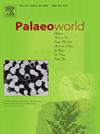Middle Campanian to Maastrichtian Foraminifera and biomarkers: Seawater incursion events in the Songliao Basin, Northeast China
IF 1.7
3区 地球科学
Q2 PALEONTOLOGY
引用次数: 0
Abstract
The Songliao Basin, spanning approximately 260,000 km2 in Northeast China, is one of the largest oil-bearing lacustrine basins. Seawater incursion events have previously been discovered in the Turonian (lower and the uppermost Qingshankou Formation) to the Santonian and early Campanian (the first and second members of the Nenjiang Formation). We newly discovered benthic and planktonic foraminifera in the middle Campanian to Maastrichtian (Fifth Member of the Nenjiang Formation, Sifangtai, and Mingshui formations) in the ZKD-1 borehole. The Planktonic foraminifera include Archaeoglobigerina blowi, A. cretacea, and Globotruncanella sp. The benthic foraminifera include Anomalinoides sp., Gavelinella sp., and Haplophragmoides sp. Among them, A. blowi, A. cretacea, Anomalinoides sp., Gavelinella sp., Haplophragmoides sp. are widely distributed in the marine strata of the Upper Cretaceous. We tested the marine biomarker compounds including C30 24-n-propyl cholestane and C30 24-iso-propyl cholestane, indicating that the Songliao Basin experienced seawater incursion events to varying degrees during the middle to late Campanian. We also found abundant charophyte fossils in the ZKD-1 borehole, including Atopochara trivolvis ulanensis, Latochara yuananensis, Feistiella anluensis, Mesochara biacuta, M. gobica, and M. leiocarpa. Among them, the brackish water charophyte fossils of Feistiella anluensis were first found in Songliao Basin.
松辽盆地中坎帕阶—马斯特里赫特阶有孔虫及其生物标志:海水入侵事件
松辽盆地位于中国东北,面积约26万平方公里,是中国最大的含油湖盆之一。在吐鲁番统(青山口组下段和上段)至三东统和早坎帕纪(嫩江组一段和二段)均发现过海水入侵事件。在ZKD-1钻孔新发现坎帕阶中—马斯特里赫特(嫩江组五段、四方台组、明水组)底栖和浮游有孔虫。浮游有孔虫包括Archaeoglobigerina blowi、A.白垩纪、Globotruncanella sp.底栖有孔虫包括Anomalinoides sp.、Gavelinella sp.、Haplophragmoides sp.,其中A. blowi、A.白垩纪、Anomalinoides sp.、Gavelinella sp.、Haplophragmoides sp.广泛分布于上白垩统海相地层中。通过对C30 24-正丙基胆甾和C30 24-异丙基胆甾等海洋生物标志物的检测,表明松辽盆地在坎帕拉世中晚期经历了不同程度的海水入侵事件。在zpd -1钻孔中还发现了丰富的蕨类化石,包括Atopochara trivolvis ulanensis、Latochara yuananensis、Feistiella anluensis、Mesochara biacuta、M. gobica和M. leiocarpa。其中,在松辽盆地首次发现安露费斯提拉(Feistiella anluensis)半咸淡水蕨类化石。
本文章由计算机程序翻译,如有差异,请以英文原文为准。
求助全文
约1分钟内获得全文
求助全文
来源期刊

Palaeoworld
PALEONTOLOGY-
CiteScore
4.00
自引率
5.90%
发文量
95
期刊介绍:
Palaeoworld is a peer-reviewed quarterly journal dedicated to the study of past life and its environment. We encourage submission of original manuscripts on all aspects of palaeontology and stratigraphy, comparisons of regional and global data in time and space, and results generated by interdisciplinary investigations in related fields. Some issues will be devoted entirely to a special theme whereas others will be composed of contributed articles. Palaeoworld is dedicated to serving a broad spectrum of geoscientists and palaeobiologists as well as serving as a resource for students in fields as diverse as palaeobiology, evolutionary biology, taxonomy and phylogeny, geobiology, historical geology, and palaeoenvironment.
Palaeoworld publishes original articles in the following areas:
•Phylogeny and taxonomic studies of all fossil groups
•Biostratigraphy, chemostratigraphy, chronostratigraphy
•Palaeoecology, palaeoenvironment and global changes throughout Earth history
•Tempo and mode of biological evolution
•Biological events in Earth history (e.g., extinctions, radiations)
•Ecosystem evolution
•Geobiology and molecular palaeobiology
•Palaeontological and stratigraphic methods
•Interdisciplinary studies focusing on fossils and strata
 求助内容:
求助内容: 应助结果提醒方式:
应助结果提醒方式:


